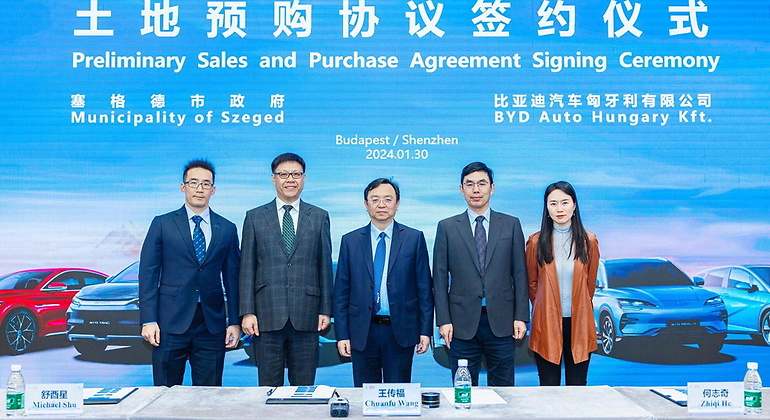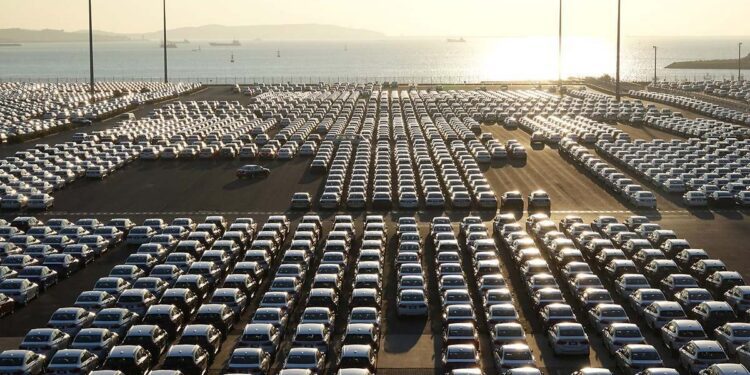The United States has revived the trade war after three and a half years of simmering tension, focusing on the electric car at the center of the conflict. Last Tuesday, the White House released a statement revising tariffs imposed on key sectors of China. At the top of the list was the electric car, which saw tariffs increase from 25% to 100% this year. President Biden himself explained that he wants to avoid cheap electric cars flooding the U.S. market, which could significantly harm the domestic industry and weaken a sector that is leading the way in a new era of transportation. However, despite initial concerns, the Chinese firms have not experienced any major disruptions following the news, as nothing seems to have changed… except that now Europe becomes the main battleground in the Beijing-Brussels confrontation.
The experts agree that nothing changes after the announcement. The reason is clear: China does not sell in the U.S. According to KBB figures, a total of 1.2 million electric vehicles were put on the market in 2023, of which only 2% were from Chinese companies. Beacon Policy analysts explained in a note to their clients that “it is very unlikely that the tariff will have an impact on the U.S. market, and at this level, it will only discourage buying EVs from this country in the future.” For this consulting firm, the reason for making the electric car the flagship of the new measures is to “provide the president with a clear talking point in the campaign.”
This is why BYD, the world’s largest producer, stated shortly after the news was announced that “we have no plans to enter the U.S. market,” so this news does not affect us at all. Stella Li, director of BYD America, defended this decision. However, this move is not without meaning for analysts. China is exporting electric cars at a massive pace. In fact, since 2021, its exports have quadrupled to $34 billion, growing by 62% year-on-year. But the Asian country ‘needs’ to continue growing to sustain its strong structure.
Why is China ‘flooding the world’ with cars?
The reason behind this trend is not only due to their competitiveness but also a drastic change in their domestic market reality that has forced their automotive sector to look abroad to salvage an overproduction capacity. In fact, the key moment to understand the ‘invasion’ of EVs was in mid-2023. At that time, the sector was ‘on fire,’ dreaming of a post-COVID Chinese market thirsty for cars. With public incentives for their purchase, it was a great business opportunity, forming a business network of 500 companies (according to RSM) intending to compete for the local market.
However, domestic demand collapsed by 28% as the slowdown in the Chinese economy was confirmed (according to data from the China Association of Automobile Manufacturers), and consumer tax incentives were cut. Morgan Stanley points out that “the local market is plagued by strong competition, with a huge cost to profitability.” This ‘slowdown’ has created an unprecedented surplus. According to estimates by the research firm Automobility, this year, the excess capacity is between 5 and 10 million cars. By 2025, they expect more than 36 million electric cars to be produced and sales to reach only 17 million. This means that there will be an excess of 20 million units that need to be ‘injected’ into the global market, even at very low prices.
“U.S. measures are aimed at not becoming a landfill for subsidized Chinese electric vehicles”
“China has a significant problem with excess capacity of electric vehicles. They are producing too many electric vehicles (heavily subsidized electric vehicles) for the domestic market and have no choice but to look overseas to dispose of those vehicles at economical prices. It is already happening in Europe,” said John Bozzella, president and chief executive officer of the Alliance for Automotive Innovation. “U.S. measures are aimed at not becoming a landfill for subsidized Chinese electric vehicles.”
The RSM analysts also point out that “aside from the shrinking domestic market” and the resulting “overcapacity,” China’s advantage over its rivals comes “from a decade of development throughout the value chain.” From “pioneering battery technology” to “obtaining reliable sources of raw materials.” However, they also acknowledge that “strong government support” has been crucial. China’s support has not only been in the form of tax incentives for manufacturers and users but also investment in a large infrastructure. European and U.S. suspicion that China has directly injected public money through industrial development programs. According to the German Institute for Economic Research in Kiel, BYD has received nearly €3.4 billion in direct subsidies over the past four years.
However, despite Chinese cars attempting to enter all possible markets, they have critically overlooked the U.S. The reason is that the country already had a 25% tariff on these products, making it difficult to compete against companies like Tesla. In that sense, Biden’s measure aims to protect his industry from further escalation in supply… but has shifted the focus to Europe, which now becomes the primary target for Asian manufacturers.
The Battle for Europe
In his latest report, Joseph Webster, an analyst at the Atlantic Council, explains that the measures taken by Biden could “force Brussels to intervene” against a massive influx of Chinese trade to Europe, now that expansion plans in this other major market face this enormous barrier. “It must act quickly to face a true flood of ‘made in China’ products.” Alicia García Herrero, an economist at Natixis, agreed that “the EU cannot remain idle as it will now be the main target. This means more pressure to impose similar measures.”
BYD itself has confirmed that this region is key to its medium-term strategy. In fact, they have ensured that they “expect to be responsible for 5% of sales in Europe by 2026.” According to the European Federation for Transport (T&E), they expect that by 2024, Chinese electric cars already account for 11% of total sales in the Eurozone, a figure they believe could rise to 20% by 2027.
The possibility of sanctions is on the table. In fact, Brussels announced at the end of 2023 the opening of a formal investigation into the electric car due to possible ‘illegal subsidies.’ If resolved favorably, measures could be taken similar to those taken by Washington. In early March, the EC expressed concern about the arrival of 200,000 vehicles only between October 2023 and January 2024. At that time, they announced the possibility of retroactive sanctions because “there is a risk that producers will be affected in their sales and production by allegedly altered prices due to subsidies, harm that is difficult to repair.”
“Operating globally is an advantage for us and we can jeopardize it by imposing tariffs”
According to Citi, the EU accounted for 36% of Chinese electric vehicle exports last year, more than the next five largest markets combined. In contrast, the United States currently receives only 1.1% of Chinese electric vehicle exports. In other words, Europe is the main market for companies in the sector. “The coming weeks will be crucial,” said Josh Lipsky, senior director of the Atlantic Council. “If Europe and G7 countries align with or mirror U.S. policies… Beijing may realize that this time is different.” In fact, in the White House document raising tariffs on China, they discuss future dialogues with allies to coordinate a ‘joint defense’ against Beijing’s trade offensive.

In any case, the battle in Europe must be fierce; otherwise, the massive influx of these vehicles cannot be stopped. Rhodium Group analysts believe that a tariff of between 40% and 50% would be needed in Europe for this market to stop being attractive. According to T&E, at least a 25% tariff would be needed to slow down their sales.
However, in Europe, there is not as clear a perception as in the U.S. that the path of ‘trade war’ is the most convenient to ensure their interests and those of the companies in these countries in the short and medium term. BMW’s CEO, Oliver Zipse, warned during a response while presenting the results that “operating globally is an advantage for us and we may jeopardize it if we impose tariffs.” Volkswagen expressed the same opinion, stating concerns about “retaliations.” Thomas Schafer, the company’s CEO, explained, “I don’t believe in tariffs; I think everyone should compete on equal terms.”
The senior executive’s words reflect that the China-EU tariff battle is much more delicate than its counterpart. According to Sino Auto Insights, the German industry, and hence the European industry, is heavily interconnected with China and could be severely affected by a tariff exchange. According to European Commission data, the auto sector was the EU’s leading export product to China, with about €223 billion in shipments.
A ‘friendlier’ invasion
However, despite all the focus being on the European continent, the danger for the U.S. industry is not completely avoided with tariffs. RSM experts point out that one of the biggest sources of danger for these measures comes from “an increasing number of Chinese companies setting up in Mexico.” In that sense, consultants point out that companies may try to bypass the tariffs imposed by the U.S. by entering vehicles through the southern neighbor.
BYD presented its Shark van in Mexico last Tuesday. This model represents the company’s bet to compete in the country with Ford and General Motors. However, there are concerns that the plants built or cars sent to the nation could end up in the U.S. The company’s regional director was asked about this due to the growing concern that this situation could lead to Mexico also becoming a target of tariffs from its neighbor. “We have built a plant in this country, only for the local market and others in the region, but we have not considered the US.”
This situation has not gone unnoticed, and Katherine Tai, a representative of the U.S. Chamber of Commerce, warned that additional tariffs will be imposed to stop Chinese production from moving to Mexico to avoid tariffs. “There may be changes in rules to tax products from China that originate in Mexico and other countries. It is a pattern that is developing and concerns us. We will use all available measures to address this problem.”


